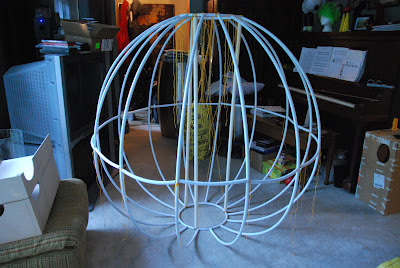I take no credit for this amazing prop, that goes to my mum, who undertook this impossible task and made it happen.
I will still show you how she made it. ;D
She started off with flexible plumbing pipe. She used math to figure out the circumference of a 5ft diameter circle, and determined how long each piece needed to be.
She started off with flexible plumbing pipe. She used math to figure out the circumference of a 5ft diameter circle, and determined how long each piece needed to be.
She made a circle for the top, and one for the bottom. These are what she would tie off the ribs to.
Once all 14 ribs were cut I helped to string them to the top ring. First we fed the cord through the pipe, looped it around the ring and then fed it back through the pipe, securing it with a bulldog clip.
Once all 14 were on I numbered them at the top and bottom with a sharpie so they wouldn't get mixed up.
Then she measured around the ringand evenly spaced the ribs, taping them in place and marking them.
Then we tied them to the bottom ring and taped those in place.
We realized that in order for it to stay it needed support beams. So 3 vertical supports were added.
We noticed that the supports were a bit too long, making it slightly egg shaped. She took off a couple inches from the supports to fix this. You can see the difference between before (left) and after (right) above.
One huge problem that we started to encounter was that the frame wanted to twist. We knew that the only way to really prevent this was that the connections for the ribs needed to be rigid. But, in order to store this, we needed it to be collapsable. (So we couldn't just glue the ribs into place.)
At this point we agreed that with all of the supports that were going in to hold up the frame, this was not going to be wearable as a costume, and would have to just be a large prop. This is when we decided to make the Prince costume.
Mum added cross-bracing in an attempt to prevent the twisting.
Then she began to work on the pattern pieces for the cover. She used a roll of tracing paper to help her make the ribs equal distance apart and then traced the shape onto tracing paper.
Then she began to pattern the bumps which required a lot of math.
First she decided the width of each ring. Then she had to decide the circumference of each ring, at the inside and outside, then she divided each of those numbers by the same number. Then she drew out a symmetrical trapezoidal template using the numbers that her math gave her to be the length of the top and bottom.
Using this trapezoid (which is green in the picture below), she drew a C-shape, by drawing the trapezoids with the edges touching. Draw the same number of trapezoids that you divided your original circumferences by. Then smooth out the edges and voila!
Here is the pattern she came up with for the different rings. ;D
Then she made the prototype bump and stuffed it, just to make sure everything was correct.
Then she sewed the ball cover together.
By using the frame, she was able to figure out the placement of the bumps.
More supports were added, but the frame still wasn't holding up very well... D:
Assembly line time! Each bump had 2 margarine containers in it to save on stuffing.
Mum relief clipping for easier sewing of reverse curves.
Elanne of Sweet Boake made all of our paper cranes. ;D
Hooks and eyes were used to attach the cranes to the ball, meaning that they are removable.
Looks like an egg...
Discs of cotton batting were cut out so that the stuffing wasn't lumpy.
Then the bumps were painstakingly hand stitched on.
The collapsing frame made it too difficult to stitch, so the frame was removed. A piece of cardboard was inserted under the area being hand stitched so that the cover wasn't accidentally stitched to itself.
12 bumps and MANY hours later...
The frame was absolutely not going to work, so we scrapped it and filled the katamari with 60+ beach balls.
It took a long time to blow them up until we found a pump!








































Lol, bet you're glad that's all done and over with!
ReplyDelete